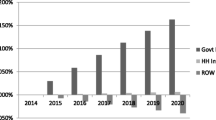Abstract
Bayesian dynamic stochastic general equilibrium (DSGE) models combine microeconomic behavioural foundations with a full-system Bayesian likelihood estimation approach using key macro-economic variables. Because of the usefulness of this class of models for addressing questions regarding the impact and consequences of alternative monetary policies they are nowadays widely used for forecasting and policy analysis at central banks and other institutions. In this paper we provide a brief description of the two main aggregate euro area models at the ECB. Both models share a common core but their detailed specification differs reflecting their specific focus and use. The New Area Wide Model (NAWM) has a more elaborate international block, which is useful for conditioning the euro area projections on assumptions about foreign economic activity, prices and interest rates and to widen the scope for scenario analysis. The Christiano, Motto and Rostagno (CMR) model instead has a more developed financial sector, which allows it to be used for monetary and financial scenarios and for cross checking. Based on the comparison of two models we find a broad agreement on the qualitative predictions they make, although, in quantitative terms, there are some differences. However, the perspectives provided by the two models are often complementary, rather than conflicting.
Article PDF
Similar content being viewed by others
Explore related subjects
Discover the latest articles and news from researchers in related subjects, suggested using machine learning.Avoid common mistakes on your manuscript.
References
Bernanke B, Gertler M, Gilchrist S (1999) The financial accelerator in a quantitative business cycle framework. In: Taylor JB, Woodford M (eds) Handbook of macroeconomics. Elsevier Science, North-Holland, Amsterdam, New York, pp 1341–1393
Canova F, Sala L (2009) Back to square one: identification issues in DSGE models. J Monetary Econ 56(4): 431–449
Chari VV, Christiano LJ, Eichenbaum M (1995) Inside money, outside money and short term interest rates. J Money Credit Banking 27: 1354–1386
Chari VV, Kehoe P, McGrattan E (2008) New Keynesian models: not yet useful for policy analysis. NBER Working Paper 14313
Christensen I, Dib A (2009) Monetary policy in and estimated DSGE model with a financial accelerator. Working Paper 06-9, Bank of Canada
Christiano LJ, Eichenbaum M, Evans C (2005) Nominal rigidities and the dynamic effects of a shock to monetary policy. J Political Econ 113: 1–45
Christiano LJ, Motto R, Rostagno M (2003) The great depression and the Friedman–Schwartz hypothesis. J Money Credit Banking 35(6, pt. 2): 1119–1198
Christiano LJ, Motto R, Rostagno M (2007) Shocks, structures or policies? The Euro Area and the US After 2001. J Econ Dyn Control 32(8): 2476–2506
Christoffel K, Coenen G, Warne A (2008) The new area-wide Model of the Euro Area: a micro-founded open-economy model for forecasting and policy analysis. ECB Working Paper 944
Collard F, Dellas H, Smets F (2009) Imperfect information and the business cycle. mimeo, University of Bern
Dieppe A, Pandiella AG, Willman A (2009) An estimated multi-country model simulated under rational expectations. ECB mimeo
Gali J (2009) The return of the Wage Phillips Curve. Working Paper, June 2009, CREI
Gerali A, Neri S, Sessa L, Signoretti F (2009) Credit and banking in a DSGE model of the Euro Area. Mimeo, Banca d’Italia
Gertler M, Karadi P (2009) A model of unconventional monetary policy. Mimeo
Gomes S, Jacquinot P, Pissani M (2009) EAGLE: a model for policy analysis of macroeconomic interdependence in the Euro Area, mimeo
Iacoviello M (2004) House prices, borrowing constraints and monetary policy. Am Econ Rev
Jacquinot P, Straub R (2008) Globalization and the euro area, simulation based analysis using the new area wide model. ECB Working paper 907
Kiyotaki N, Moore J (1997) Credit cycles. J Political Econ 105: 211–248
Mackowiak B, Smets F (2009) Implications of micro price data for macro-economic models. In: Fuhrer J (ed) Understanding inflation and the implications for monetary policy: a Phillips curve retrospective, Conference held by the Federal Bank of Boston. MIT Press, Cambridge (in press)
McAdam P, Lombardo G (2009) Financial market frictions in a small open economy for the euro area, mimeo
Milani F (2006) A Bayesian DSGE model with infinite-horizon learning: do “mechanical” sources of persistence become superfluous? Int J Central Banking 2(3): 87–106
Milani F (2008) Learning, monetary policy rules, and macroeconomic stability. J Econ Dyn Control 32(10): 3148–3165
Slobodyan S, Wouters R (2009) Estimating a medium-scale DSGE model with expectations based on small forecasting models, mimeo, National Bank of Belgium
Smets F, Wouters R (2003) An estimated dynamic stochastic general equilibrium model of the euro area. J Eur Econ Assoc 1(5): 1123–1175
Smets F, Wouters R (2004) Forecasting with a Bayesian DSGE model: an application to the euro area. J Common Mark Stud 42(4): 841–867
Smets F, Wouters R (2005) Bayesian new neoclassical synthesis models: modern tools for central banks. J Eur Econ Assoc 3(2–3): 422–433
Smets F, Wouters R (2007) Shocks and frictions in US business cycles: a Bayesian DSGE approach. Am Econ Rev 97(3): 586–606
Author information
Authors and Affiliations
Corresponding author
Additional information
Prepared for a special issue of the Spanish Economic Review. The opinions expressed are our own and should not be attributed to the European Central Bank or its Governing Council.
Rights and permissions
Open Access This article is distributed under the terms of the Creative Commons Attribution 2.0 International License (https://creativecommons.org/licenses/by/2.0), which permits unrestricted use, distribution, and reproduction in any medium, provided the original work is properly cited.
About this article
Cite this article
Smets, F., Christoffel, K., Coenen, G. et al. DSGE models and their use at the ECB. SERIEs 1, 51–65 (2010). https://doi.org/10.1007/s13209-010-0020-9
Received:
Accepted:
Published:
Issue Date:
DOI: https://doi.org/10.1007/s13209-010-0020-9



